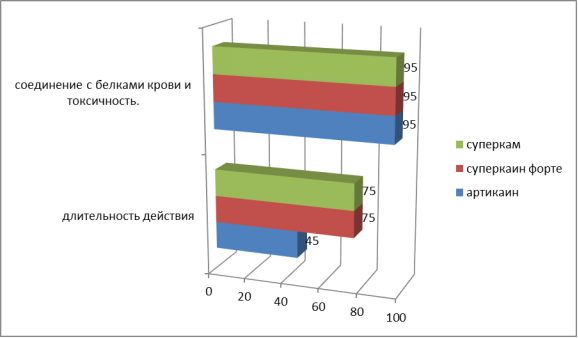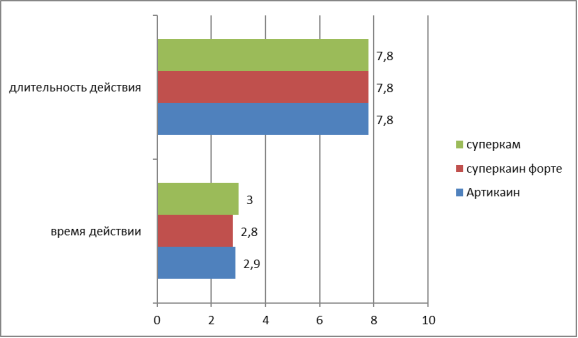The success of modern dentistry is largely due to the development and implementation in practice of new tools and methods that allow painlessly carry out long and large — scale interventions in the oral cavity. The most effective and safe way of anesthesia on an outpatient dental reception is local anesthesia (M. G. Panin, 1969; A. F. Bizyaev, 1998; S. F. Gritsuk 1998; S. A. Rabinovich, 2000; R. S. Brown, 1994; S. Malamed, 1994, 1997; etc.). For the time being. The most effective of them are recognized drugs created on the basis of articaine, due to the peculiarities of its pharmacokinetics and pharmacodynamics (H. Lemay, 1984; R. Rahn, 1996, S. Malamed, 1997; A. J. Petrikas, 1997; L. A. Grigoryants, A. P. Shafransky, 1999; E. V. Zoryan, E. N. Anisimova, 2002; S. A. Rabinovich et al., 2005, 2006; E. V. Zoryan, S. A. Rabinovich, 2005; S. A. Rabinovich, E. V. Zoryan, 2006; etc.).
The articaine containing products produced by various foreign companies and is known for its proprietary trade names: al-fakin (Densply, France), Articaine of INIBSA (Inibsa, Spain), Prilocain (Russia), Primaquin (France), Septanest (Septodont, France), Ubistesin (ZM ESPE, Germany), Ultracain (Sanofi-Aventis, Germany), Cytokeratin (Italy). The main component of all these drugs is a local anesthetic — articaine, which determines, on the one hand, the General features of the action of all these drugs, and on the other-their distinctive features in comparison with drugs created on the basis of lidocaine or mepivacaine. Articaine, lidocaine and mepivacaine are international nonproprietary names (INN), which are indicated along with trade names (E. V. Zoryan, S. A. Rabinovich)
Key words: anesthetics, rural population, articaine.
Local anesthetics are substances that, when interacting with nerve fibers and their endings, can reversibly inhibit the formation and conduction of nerve impulses on them. The effect of local anesthesia depends not only on the properties and concentration of the drug, but also on the thickness of the myelin sheath of the nerve fiber that prevents the penetration of the anesthetic through the cell membrane. Search and improvement of methods of local anesthesia is one of the most important tasks of modern dentistry. The main task of local anesthesia is to achieve anesthesia of the necessary tissue area, and all other effects of its action are considered as side effects. To do this, we need to know the objective assessment of the anesthetic.
The aim of our study was: to Study the features-actions* of modern domestic articaine-containing anesthetic «Supercain» to improve the efficiency and safety of local anesthesia by introducing into dental practice. Experimentally and clinically justify the advantages and disadvantages of anesthetics. Find the optimal use of local anesthetics in the rural population.
Materials and methods of research:
- Clinical examination of patients.
- Statistical methods of processing the results of the study.
- Laboratory research methods.
For the study were taking 30 patients, which we divided into 3 groups. In group I the anesthetic Articaine was used. In the second group used the drug superchain Forte. In group III, was used in the preparation supercam.all these drugs are generic drug Ubistesin. Ubistesin combined preparation for local anesthesia in dentistry. Part of it, the articaine is a local anesthetic of the amide type titanovoe group. Due to the low content of epinephrine in the drug, its effect on the cardiovascular system is expressed little: there is almost no increase in blood pressure and an increase in the heart rate. Articaine with submucosal administration in the oral cavity has a high diffuse ability. Active substances to a minimum extent penetrate the placental barrier, practically do not stand out with breast milk.
The results of the study: there Were several criteria by which the patient's condition and the action of the anesthetic were evaluated. The first criterion: the time of anesthesia. In group I patients, the anesthetic action began after administration after 2±1min. In group II and III patients, the duration of the anesthetic began as well as in group I after 2±1 min.
The second criterion: the duration of the anesthetic. From I and III group of patients the duration of action of anesthetic is at least 45min. Have II group of patients the duration of action of anesthetic is at least 75 minutes.

Third criterion: the connection with the blood supply and toxicity. The degree of binding to plasma proteins determines the half-life of the drug, the duration of its presence in the body. The higher this figure, the less toxic the anesthetic has, since it can be absorbed into the blood only in free form, and the longer the anesthetic effect. All groups of compounds with blood proteins is 95 %, it gives us a full right to say that the toxicity of these drugs is reduced to a minimum.
The fourth criterion: dissociation constant (CD) characterizes the degree of hydrolysis and ionization of the anesthetic and depends on its chemical structure, solubility and pH of tissues at the injection site.
At physiological pH (7.4), the lower the anesthetic CD, the less molecules dissociate in the extracellular environment and the more — inside the cells. For example: CD lidocaine and mepivacaine is 7.7, which means that 65 % of the anesthetic is ionized in the extracellular environment, and 35 % reach the cytoplasm, where the anesthetic effect is realized (the rate of anesthesia — 2–4 minutes).As it is told in the summary of preparations at all groups of tested anesthetics it is revealed that CD is equal to 7,8.

Conclusions: the results of our studies showed that all three groups of drugs are similar to their qualities and parameters. Thanks to this, the state dental clinics, which form the basis of the system of outpatient treatment of dental diseases in the population, could switch to the use of advanced anesthesia technology. Therefore, we can use all three types of anesthetic in the rural population.
References:
- Anisimova E. N. Clinical rationale for the choice of funds for local anesthesia in outpatient dental interventions. -Autoref.. kand.honey.sciences'. M.: 1998. — 24 p.
- Anisimova E. N., Zoryan E. V., Shugaylov I. A. the Action of local anesthetics and their combinations with vasoconstrictors. //Dentistry. 1998. — Vol. 77. — № 2. — P. 19–22.
- Bazhanov N. N. Experience the use of adrenaline in dentistry. //Health Care In Belarus. 1963. — № 4. — p. 81–83.
- Bazhanov N. N., Ganina S. S. Anesthesia in polyclinic dental practice. — M.: Medicine, 1979. 192 p.
- Bizyaev A. F. Local anesthesia. //In kN.: Handbook of dentistry (edited by V. M. Bezrukov), section.2. M. «Medicine»., 1998. — P. 24–48.







